When specifying a pressure range for a hydraulic system there maybe the risk of high pressure spikes caused by sudden opening and closing of valves. This is analogous to what happens when you turn a water tap on or off too quickly, which results in a knocking sound caused by the pipes absorbing energy generated by the change in momentum of the water in system.
These over-pressure surges can be extremely high but typically their duration is very short and the energy of the shockwave will dissipate as it propagates through the system.
So the location of the pressure sensor can be a key factor in minimising the effects of over-pressure, but also the selections of the pressure range and sensor technology are key factors in over-pressure protection as well.
Over pressure spikes can be very difficult to predict and measure so in these cases the maximum over-pressure required can only be determined by experimentation by using a strain gauge output pressure sensor and an oscilloscope or other high frequency signal measuring instrument.
A strain gauge output pressure sensor has a millivolt output signal with no signal amplification so the dynamic response is close to the natural frequency of the sensing diaphragm which is often very high for high pressure ranges in the x10KHz range.
Since accuracy is not important in investigating over-pressure, choose a much higher pressure range than you need. This will protect the sensor so that you can use it again and again to build up a profile of over-pressure spikes at different mounting locations.
Even if a high range is used you may still notice that the zero reading of the overpressure test sensor has changed due to over-pressure spikes. The higher the overpressure spike the greater the zero offset. Although this is not a very accurate indicator the level of offset can be used to compare over-pressure at different mounting locations.
Once you have an understanding of the characteristics of pressure spikes in your system you can then consider what type of pressure sensor to use. Specifying a pressure sensor with a high overpressure rating will help since often you will be fitting a pressure sensor with a proportionally thicker diaphragm. But some over-pressure spikes have huge amplitudes many times greater than the normal operating conditions. In these cases the most effective method of over-pressure protection is the fitting of a snubber.
A snubber is a restriction that is introduced into the process connection, which can be achieved by reducing the diameter of pressure port or inserting a filter plug, which will dampen pressure spikes generated by a dynamic hydraulic system and protect the diaphragm. A snubber can be incorporated by the pressure sensor manufacturer or sourced as an adapter accessory.
Related Help Guides
- What is difference between working, burst and over pressure
- Symptons and Causes of Damage to Pressure Transducer Diaphragms
- Selecting a pressure range for optimal service life and accuracy

